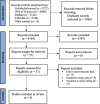Predictors of successful vaginal birth after a cesarean section in Ethiopia: a systematic review and meta-analysis
- PMID: 36703101
- PMCID: PMC9878746
- DOI: 10.1186/s12884-023-05396-w
Predictors of successful vaginal birth after a cesarean section in Ethiopia: a systematic review and meta-analysis
Abstract
Background: The rates of successful vaginal birth after previous cesarean section (VBAC) have been increasing with minimal complication. Successful vaginal birth after cesarean section improves maternal and fetal outcomes by shortening the length of hospital stay, avoiding abdominal surgery, decreasing the risk of infections and hemorrhage, and decreasing injury of the bladder and bowel. Despite a few single studies stating different predictors of successful VBAC, there is a lack of nationwide data to show the determinants of successful VBAC. Thus, this meta-analysis aimed to determine the predictors of successful VBAC in Ethiopia.
Methods: A systematic literature search was performed from PubMed, Web of Sciences, EMBASE, CINAHL, and Google scholar until July 25, 2022. The quality of included studies was evaluated using the Joanna Briggs Institute (JBI) critical appraisal checklist. The analysis was executed using Stata 14 statistical software. Heterogeneity was evaluated statistically using Cochran's Q-statistic and quantified by the I2 value. A random-effects model was used to estimate the determinants of successful vaginal birth after a cesarean section if substantial heterogeneity was detected across included studies; otherwise, a fixed-effects model was used.
Results: Women living in rural residence (AOR: 2.14; 95% CI: 1.01, 4.52), history of previous spontaneous vaginal delivery (AOR: 2.92; 95% CI: 2.02, 4.23), previous successful vaginal birth after previous cesarean section (AOR: 5.29; 95% CI: 2.20, 12.69), history of stillbirth (AOR: 1.57; 95% CI: 1.20, 2.04), cervical dilation of ≥ 4 cm at admission (AOR: 2.14; 95% CI: 1.27, 3.61), spontaneous ruptured membranes at admission (AOR: 1.32; 95% CI: 1.17, 1.48) were independent determinants of successful vaginal birth after previous cesarean section.
Conclusion: The results of this meta-analysis showed that successful VBAC was influenced by past and present obstetric conditions and other predictors. Thus, it is recommended that obstetric care providers should emphasize those factors that lead to successful vaginal birth during counseling and optimal selection of women for the trial of labour after cesarean section.
Systematic review and meta-analysis registration: PROSPERO CRD42022329567.
Keywords: Systematic review; Vaginal birth after cesarean section.
© 2023. The Author(s).
Conflict of interest statement
The authors declare that there are no competing interests.
Figures







References
Publication types
MeSH terms
LinkOut - more resources
Full Text Sources
Medical
Miscellaneous

